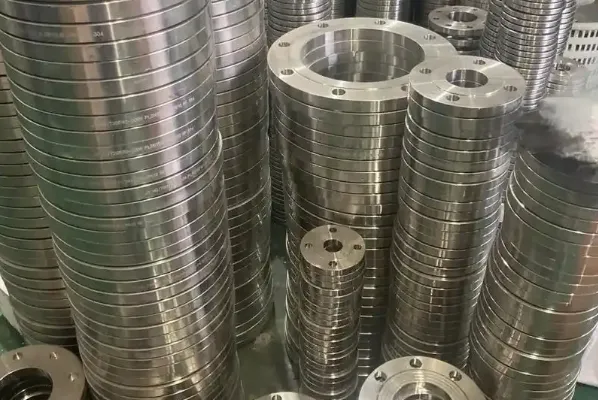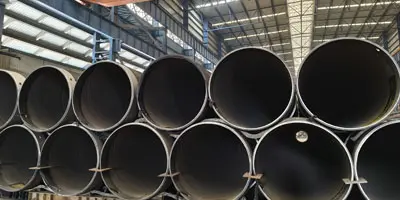Carbon steel flanges are fundamental components used in a wide range of industrial piping systems. Their primary role is to connect pipes,
valves, pumps, and other equipment to form a complete pipeline infrastructure. These flanges offer high strength, excellent sealing capabilities, and are typically more cost-effective compared to other alloy or stainless-steel variants.
This article explores the most common materials and standards for carbon steel flanges, the differences between forged and cast iron variants, and methods to prevent corrosion. Whether you’re an engineer, project manager, or procurement specialist, understanding the characteristics of carbon steel flanges will help you make better purchasing and application decisions.
Common Materials and Standards for Carbon Steel Flanges
Primary Materials
Carbon steel is the main material used in flange manufacturing due to its strength, affordability, and versatility. It contains a carbon content up to 2.1% by weight and is usually alloyed with iron. The amount of carbon determines the steel’s hardness and mechanical strength, but also its ductility and weldability.
Standards for Carbon Steel Flanges:
ASTM A105 / A105N (SA105N): Widely used for forged carbon steel piping components in ambient and high-temperature service.
ASTM A350 LF2: Designed for low-temperature service, offering high impact toughness and notch resistance.
ASTM A694: Used in high-pressure transmission service, often in oil and gas industries, with grade numbers reflecting yield strength.
DIN 2533: German standard for carbon steel flanges.
MSS SP-44: Specification for large diameter steel pipeline flanges used in high-pressure systems.
These standards determine the chemical composition, mechanical properties, manufacturing method, and inspection requirements for each flange type.
ASTM A105N (SA105N) Flange Material
ASTM A105N is one of the most common grades of carbon steel used for manufacturing flanges. It is especially popular for ambient and high-temperature service applications. The “N” denotes “normalized,” meaning the steel has been heat-treated to improve toughness and uniformity.
Available Sizes & Classes
Standard Sizes: 18” to 42” in Blind, Weld Neck, Lap Joint, and Slip-On designs.
Pressure Classes: Class 150 and Class 300 (others available upon request, including Class 600 to 2500).
|
Element
|
Composition (%)
|
|
Carbon (C)
|
Max 0.35
|
|
Manganese (Mn)
|
0.60 - 1.05
|
|
Phosphorus (P)
|
Max 0.035
|
|
Sulfur (S)
|
Max 0.040
|
|
Silicon (Si)
|
0.10 - 0.35
|
|
Copper (Cu)
|
Max 0.40 (Note A)
|
|
Nickel (Ni)
|
Max 0.40 (Note A)
|
|
Chromium (Cr)
|
Max 0.30 (Note A, B)
|
|
Molybdenum (Mo)
|
Max 0.12 (Note A, B)
|
|
Vanadium (V)
|
Max 0.08 (Note A)
|
Notes:
Sum of Cu + Ni + Cr + Mo + V ≤ 1.00%
Cr + Mo ≤ 0.32%
For each 0.01% below the carbon max, Mn can increase by 0.06% to a max of 1.65%
Mechanical Properties:
Tensile Strength: Min 485 MPa (70,000 psi)
Yield Strength: Min 250 MPa (36,000 psi)
Elongation: Min 30% (in 2” test specimen)
Hardness: Max 187 HBW

Applications
Oil and gas pipelines
Power plants
Petrochemical industries
Refineries
Stainless steel piping systems (using lap joint rings)
Anti-Corrosion Measures for Carbon Steel Flanges
While carbon steel offers strength, it is prone to rust if not properly treated. Several surface protection methods are commonly employed:
Electroplating (Zinc-Coated):
Available in white or yellow zinc finishes
Adds corrosion resistance for indoor and mild outdoor environments
Anti-Rust Paint:
Suitable for long-term storage
Cost-effective and easy to apply
Oil Varnish:
Provides a temporary protective coating
Often used for transport and short-term protection
Heat Treatment and Welding of ASTM A105N Flanges
Heat Treatment Requirements:
Not mandatory for flanges under Class 300 or under 4” NPS
Required for:
Flanges above Class 300
Special designs with unknown design pressure/temp
Items over 4” NPS
Available Treatments:
Normalizing
Annealing
Normalizing and tempering
Quenching and tempering
Welding Capability:
All A105 components can be welded.
Procedures must follow ASME Section IX.
Standards and Related Documents
To ensure consistency and quality, carbon steel flanges are manufactured according to several global and national standards:
ASME B16.5: Pipe flanges and flanged fittings
ASME B16.47: Large diameter flanges
ASME B16.48: Line blanks
ASME B16.9/B16.11: Wrought and forged fittings
MSS SP-44: Steel pipeline flanges
ASTM A961: General requirements for forged fittings and valves
Conclusion
Carbon steel flanges are indispensable components in industrial piping systems due to their durability, cost-efficiency, and broad compatibility. Understanding the different material standards like ASTM A105N, A350 LF2, and A694—as well as the distinctions between forged and cast flanges—allows engineers and procurement teams to choose the most appropriate product for their applications.
With the right corrosion protection and compliance to industry standards,
carbon steel flanges can offer a long service life even in demanding environments. As industries expand their infrastructure, these flanges continue to play a vital role in safely transporting fluids and gases across critical systems.
Choose
BAOWI Steel for high-quality carbon steel flanges and end connectors. We offer a wide range of products, from Class 150 to 2500, complying with ASTM, DIN, and EN standards, serving industries like oil & gas, power, and chemicals. With advanced equipment and a skilled team, we ensure every product meets top international standards for strength, sealing, and durability. Contact us for customized solutions and quotes.






 English
English Español
Español بالعربية
بالعربية











 Phone :
Phone :  Whatsapp :
Whatsapp :  Email :
Email : 


